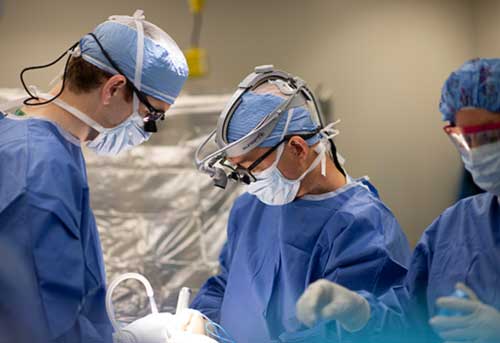Networking with the Best Spine Surgeons in St Louis MO for Comprehensive Care
Networking with the Best Spine Surgeons in St Louis MO for Comprehensive Care
Blog Article
An Introduction of Back Conditions That Typically Outcome in Surgical Therapies
Spine conditions such as herniated discs, back stenosis, and degenerative disc illness frequently necessitate medical interventions when conservative treatments stop working to ease consistent signs. These conditions not just lead to considerable pain yet can also severely hinder daily functioning and total lifestyle. Comprehending the subtleties of each condition and the matching medical choices, such as discectomy or back fusion, is critical for efficient monitoring. As we discover these conditions additionally, it becomes evident that the decision-making process surrounding medical treatment is complex and warrants cautious consideration.
Herniated Discs
Although several individuals with herniated discs might discover alleviation via traditional therapies, surgery ends up being a required consideration when signs worsen or persist - best spine surgeons in st louis mo. A herniated disc takes place when the soft inner gel of a back disc extends via its outer layer, potentially leading and compressing neighboring nerves to discomfort, numbness, or weak point in the extremities
Conventional management typically consists of physical treatment, discomfort medications, and corticosteroid injections, which aim to minimize inflammation and improve feature. Nonetheless, in instances where these approaches fall short to reduce devastating signs and symptoms, medical choices may be checked out.
The most common procedure for herniated discs is a discectomy, which entails the elimination of the herniated part of the disc to ease pressure on the influenced nerve root. In a lot more extreme instances, back blend might be needed to stabilize the impacted vertebrae.
People are advised to go over the potential dangers and advantages of surgery with their medical care supplier to make a notified decision. Inevitably, the goal of any medical intervention is to recover function, reduce pain, and boost overall lifestyle for people dealing with herniated discs.
Spinal Constriction
Back stenosis happens when the spaces within the spine narrow, causing increased pressure on the spine and nerves. This problem can develop in different areas of the spine, consisting of the cervical and back locations, commonly as a result of age-related adjustments, such as degenerative disc condition, joint inflammation, or enlarging of tendons.
Patients with back stenosis might offer with signs and symptoms that consist of discomfort, numbness, prickling, or weak point, mainly in the legs or arms. These signs and symptoms can be intensified by tasks that include standing or walking, frequently leading people to look for alleviation through conservative treatments like physical therapy, medicines, or epidural steroid injections.
Nevertheless, when these non-surgical treatments stop working to give adequate relief, medical choices may be considered. Common procedures for spinal constriction consist of laminectomy, which includes the removal of part of the vertebra to minimize stress, and back combination, which stabilizes the affected location. The choice to go after surgical procedure is typically based on the severity of signs, the degree of practical problems, and the total health of the person. Prompt medical diagnosis and management are critical to avoid more neurological compromise and enhance Recommended Reading lifestyle.
Spondylolisthesis
Spondylolisthesis takes place when one vertebra slips forward over one more, leading to imbalance of the spinal column. This problem can result from various aspects, consisting of congenital problems, trauma, or degenerative modifications in the spine. It is most frequently observed in the back area, particularly at the L4-L5 and L5-S1 degrees.
/0x0:512x512/prod01/channel_2/media/mccms/content-assets/academics/residencies-and-fellowships/spine-surgery-fellowship-minnesota/overview/final-512X512-OR710-2020-10-05_0007.jpg)
Treatment choices vary based on the intensity of the slippage and the signs and symptoms presented. Traditional actions, consisting of physical treatment, pain monitoring, and task modification, are typically the very first line of defense. Nonetheless, when non-surgical techniques stop working to ease symptoms or when substantial nerve compression exists, surgical intervention might be required. Surgical alternatives can include back blend or decompression treatments, aimed at recovering positioning and minimizing neurological symptoms. Early medical diagnosis and proper management are crucial for optimum results in patients with spondylolisthesis.
Degenerative Disc Condition

The problem can be identified with a mix of medical examination, imaging studies, and patient history. When these techniques fall short to provide ample relief, medical treatments may be taken into consideration.
Surgical alternatives for DDD might include spine combination or synthetic disc replacement, aimed at stabilizing the impacted sector and minimizing pain (best spine surgeons in st louis mo). Ultimately, the choice of therapy is embellished, taking into consideration the seriousness of the problem, patient health, and way of living variables
Spine Tumors

Spinal tumors can emerge from numerous elements, including hereditary tendency, environmental influences, and pre-existing clinical problems. Clients might offer with a range of signs and symptoms, including localized discomfort, neurological deficits, weak point, or modifications in bowel and bladder function, depending on the tumor's dimension and area.
Diagnosis generally more information includes imaging research studies such as MRI or CT scans, which assist define the lump's qualities and influence on bordering structures. In examining therapy alternatives, the tumor's quality, place, and kind are essential considerations. Surgical treatment may be find out warranted to minimize signs, obtain a biopsy, or eliminate the growth totally. The goal of surgical treatment is commonly to unwind neural aspects and support the back. Adjuvant therapies, consisting of radiation or chemotherapy, may also be necessary depending on the tumor's nature. Early detection and intervention are crucial for enhancing end results in clients with spinal growths.
Final Thought
In summary, spine conditions such as herniated discs, back stenosis, spondylolisthesis, degenerative disc condition, and back lumps often demand medical intervention due to their potential to create considerable pain and functional disability. While conservative treatments might provide short-term alleviation, surgical options end up being critical when symptoms get worse or persist. Timely diagnosis and intervention play a critical duty in recovering feature and enhancing the lifestyle for damaged people, underscoring the value of thorough back treatment.

Report this page